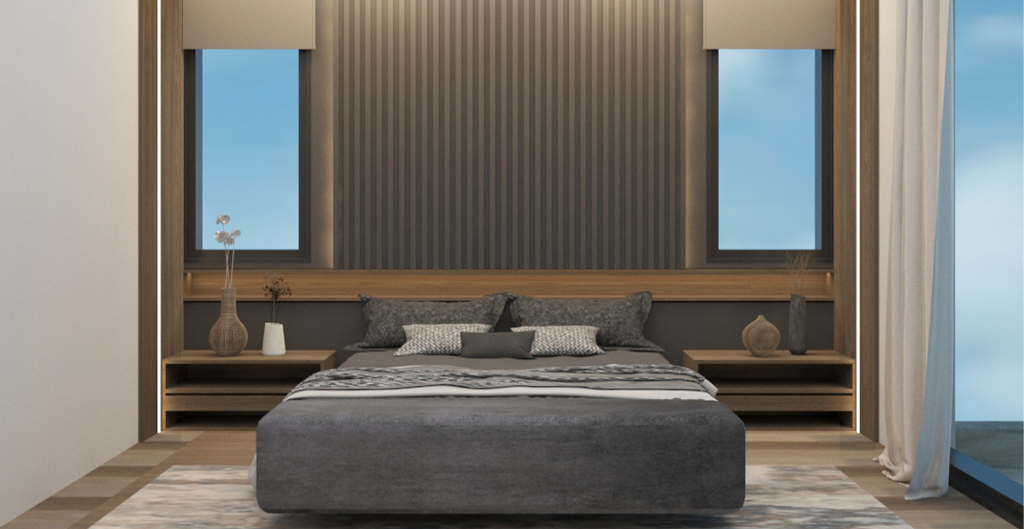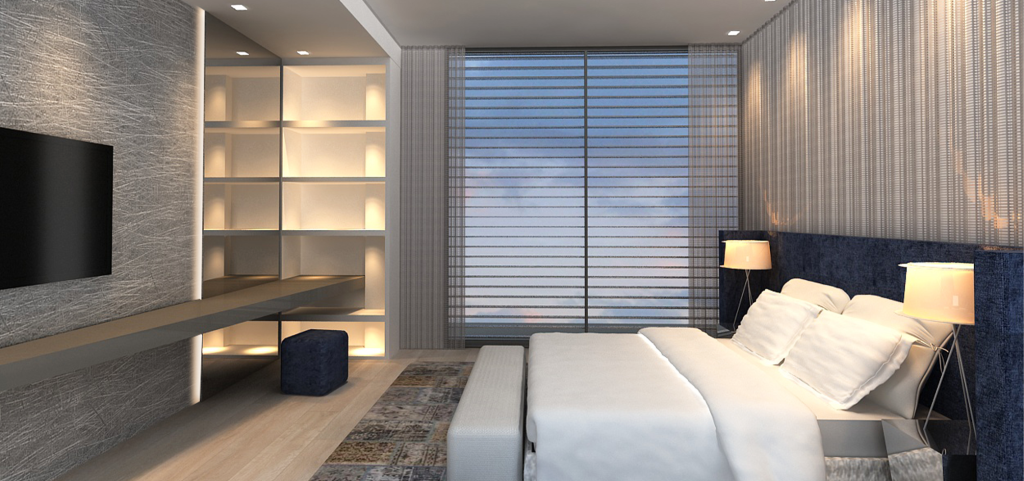Did you know that the way in which you spend your time in your bedroom determines its ideal furniture and decoration? Did you know that having a television in the bedroom is not a complementary element but, on the contrary, a key axis around which the whole layout should revolve? Do you know what is the most common mistake we unknowingly “give into” when we create the room where we sleep and wake up?
The Interior Designer and owner of the company “Annita Papamichael Interior Design Studio”, Annita Papamichael, provides answers to the above mentioned questions and makes reference to materials whose use makes our bedroom seem cold, inhospitable, as well as create bad acoustics. She provides easy solutions for converting a children’s room into a teenager’s room, she explains how we can convert a simple bedroom into a luxurious one resembling a five-star hotel, in economical ways. She shares storage tips when our personal space is small, as well as tricks that create the sense of a larger, more spacious room.
If therefore you don’t want to only have the bedroom of your dreams in thought, but you would like it to be a part of your home and everyday life… enjoy reading.
Interview: Nicola Karatzia
Translation: Stephie Karagiorge
Photographic material: Annita Papamichael Interior Design Studio
Would you say that there are categories of bedrooms based on their characteristics and if so, what are they?
I would say that one of the most important factors that categorize a bedroom, is the presence of a television, as well as how important it is to the people using the room. This determines to a large extent the position and orientation of the bed in relation to the television. At the same time, there is the category of multi-purpose bedrooms, which include a lounge, a sofa and even a desk, and which are ideal for those who spend a lot of time in there.
On the opposite side, we find bedrooms whose use is exclusively for sleeping and resting. In such a bedroom, there is only the absolutely necessary furniture.
I understand therefore that the layout that will be chosen primarily has to do with the lifestyle of the owners.
Exactly. Everyone must be clear on how they want to use their space. Whether it will be just for sleeping and personal moments, whether it will be a room where the whole family can spend time, whether they will watch television there or whether it will be used as a workspace. The design of our bedroom basically follows our personal lifestyle.
Is it important that the colors and decorations that are chosen are in line with the overall architecture and style of a bedroom, as well as with the style of the house, or is it enough that they are in line with the taste and aesthetics of the people to whom it belongs?
I believe that the philosophy of most professionals – like myself -, wants each space in the house to follow a common line and similar style in the choice of materials, so that an overall harmonious result is achieved. Besides, the style of the living room (modern, simple, classic, or luxurious) that represents a client, will most likely represent them in their bedroom too. The basic rule that is usually followed, focuses mainly on matching materials and colours that will be used in different parts of the house.
On which pillars should the layout of the space be based in order to have the ideal result and what emotions should it evoke when you are in it?
Eastern orientation is most ideal for bedrooms that need morning light. Its advantage is that the sunlight doesn’t last long, so the rooms don’t overheat.
From an aesthetic point of view, the bed should ideally be placed on a blank wall without windows, so that it has the leading role. The aim is for the master bedroom to resemble a nice hotel room, thereby referring to holidays and relaxation.
Finally, large openings/windows of full length are very nice, as long as they don’t deprive you of your privacy.
Would you say that some decorative elements, colours or materials or even the general layout, are capable of creating an ideal environment that aids in resting and sleeping, as well as in erotic mood?
As I mentioned before, the bed should play a leading role in the space, and I therefore avoid having windows and curtains on the side of the bed.
For me, ceramics and marble are prohibitive materials for bedroom flooring because they are “cold” in appearance, while walking on them with bare feet creates bad acoustics. Parquet (wood or laminate) in any color tone the customer likes, and which is in line with the philosophy of the rest of the house, is an ideal choice of floor. These materials offer the necessary warmth and tranquility that everyone seeks in their personal space.
The addition of fabrics – such as a rug and curtains – is important for enhancing the warmth and proper acoustics of the space.
Are there ways in which a small-sized bedroom can give the sense that it is bigger?
Certainly, the appropriate size of bed and nightstands should be placed in a small bedroom. Nightstands can be small tables with legs and definitely not heavy or large volumes. Instead of lampshades, it would be better to place lights on the wall, next to the bed.
Beyond that, large openings and good lighting definitely give the sense of a larger space. Although white visually helps a room look more spacious, accenting a wall with a different color or material creates depth and interest.
At the same time, a large, full-length mirror placed in a central part of the room will definitely visually enlarge the space and, at the same time, beautify it.
Are there any tricks to gain or create more storage space?
One of the most important ways to create storage space is the proper interior design of cabinets. In addition, there are beds either with drawers on the side, or in the form of a mechanism where the mattress goes up and there is storage space underneath. Complementary, one could choose nightstands with storage space, shelving units or “free-standing” shelves placed along the entire height of the room.

How important is the lining with materials, such as wallpaper, or wooden beams, for a room to gain “character”?
The lining of some walls and especially the one behind the bed, give “character” to the bedroom and make refence to a hotel which is the ultimate goal as I have mentioned before. The presence of various materials and textures, especially fabrics, enhance the aesthetics of the room.
Let me emphasize this. Often, we say “I want my bedroom to look like a room of a five-star hotel”. Is this possible, even without having to spend a fortune?
A typical luxury hotel room usually contains in addition to a large bed with a large headboard, wall lining behind it, sofa or armchairs, dressing table with a large mirror, lamps by the side of the bed. In addition, it usually has a floor lamp, “rich” in volume curtains and some artwork or photographs.
The space is full and does not consist of four bare white walls. To implement all these elements, ideally, a spacious room is needed.
As far as the furniture, lighting and decorative pieces are concerned, we should mention that there are now many shops and companies that offer for sale elegant pieces at more affordable prices.
What features should a children’s bedroom definitely have and what should be avoided in it to make it familiar to the child?
A children’s bedroom is a space that is constantly changing, because a child’s needs also change as he or she grows up. Therefore, based on this logic, I avoid making permanent structures which on the one hand are nice, but on the other, are limiting in the future. The younger a child is, the more space they need for playing, whilst as they get older, different needs arise, such as that of a desk for studying and of a bigger bed.
I suppose then that if the transition from the children’s to the teenager’s room is envisaged from the beginning, it can be achieved in easy and economical ways.
Changing a child’s single bed to a small double bed will automatically satisfy a teenager. Next, adding a simple rug, lining a wall with a minimal wallpaper usually in shades of grey, shelves with plants on them, will give another breath of renewal to the space. If we want to go one step further, there are LED strips on the market that we can purchase, which will create an interesting atmosphere. They are plugged in, change colours with a remote control, and can easily be glued under or behind the bed, desk, or nightstand.
Do you, as an interior designer, usually find the idea of “setting up” a space in a completely new building more appealing or is the idea of remodeling an existing space more tempting?
Personally, I much prefer the renovation part, because I consider it a greater challenge and, by extension, a more creative process.
The work of an interior designer does not only focus on dealing with the “superficial” aesthetic part, but also invests in design and planning. In fact, usually, from an obstacle that may be encountered in an existing house, a very clever solution may emerge that brings out a unique aesthetic result in the end. At the same time, in the case of a renovation, there is always the surprise factor, as we have as a benchmark the image of the before and after.
In closing, we would like you to share with us what you consider to be the biggest mistake that we often make when it comes to the interior design of our bedroom?
Lighting is a very important pillar in a bedroom. Ideally, there should be various sources of light so that the room can change based on the time of day. In addition to general lighting, it would be great to have concealed lighting either on a curtain rail, ceiling spotlights or a rail of mobile spotlights, or even under a piece of furniture for a more indirect and relaxing effect.
The most common image that I encounter – especially in existing bedrooms – is a central spot on the ceiling, with a low pendant light or even a fan with a built-in light fixture. The presence of only one central source in our space creates strange shadows and produces a very poor aesthetic effect.


